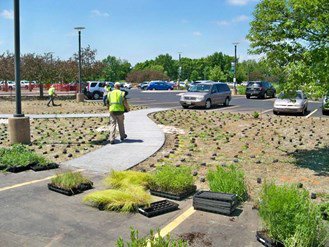
There has been a recent cultural shift toward reusable, natural, green practices in most aspects of modern society—even including wastewater systems.
An increasing amount of sewer districts are looking to green infrastructure as an eco-friendly solution for stormwater management.
Wait a minute … What’s green infrastructure?
Green infrastructure provides a mechanism where stormwater can be absorbed into the ground more slowly and filtered through sand, rocks, and other natural means before returning to waterways. This mimics the way natural areas absorb stormwater.
In many urban areas, stormwater still runs into a sewage system, which can cause problems for the sewer districts after a storm event. Green infrastructure, including pervious pavements and bioswales, can help reduce the amount of stormwater entering sewer systems. Bioswales with plants and a gravel storage layer can hold and clean large amounts of water, then direct it back to natural waterways. Pervious pavement acts similarly, reducing surface runoff to sewers and allowing stormwater to be absorbed into the ground.
Developers interested in the advantages of green infrastructure can install smaller detention basins designed to slowly absorb water and hold it for a longer period of time. This helps public sewer systems to better manage water while allowing developers to show their environmental stewardship, potentially earning them credits, certifications or awards through programs such as the USGBC’s Leadership in Energy and Environmental Design (LEED) rating system.

But what about green infrastructure maintenance?
Green infrastructure maintenance generally aligns with the seasons, but that doesn’t mean it has to be costly or time intensive. Heavy rainfall in the spring creates more stormwater runoff, and green infrastructure needs to be properly prepared for this influx. Follow these seasonal best practices:
- Inspections - Green infrastructure should be inspected periodically based on adjacent land use, activities in the watershed, and rainfall magnitude. Some maintenance items that stem from inspections, such as removing invasive plants and debris, can be done all year. Spring is a good time to remove or cut back dead plants and replace them.
- Check infiltration rates - Bioretention systems and pervious paver systems should meet specific infiltration rates. Over time, these rates may decline from sediment clogging or paver pores. Annually checking infiltration rates and tracking them over time can help identify performance issues.
- Test soil - Salt accumulations in basins next to parking lots or roadways can impact vegetation health and reduce infiltration rates. Testing the soil every two years for salt concentrations can help determine if the biofiltration soil needs replaced. While this test can be done at any time of the year, spring is the most critical for managing salt concentrations when plants are just starting to grow and rains haven’t flushed excess salts from the soils yet.
- Basic cleaning - Spring is also an important time to clear and repair inlets, stabilize bare soil in adjacent areas that contribute to stormwater, add mulch to reduce summer weeding, and remove leaves and debris to prepare for heavy rains.



